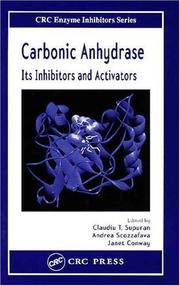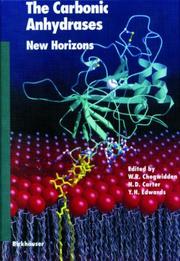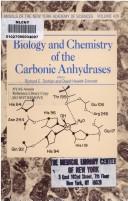| Listing 1 - 10 of 23 | << page >> |
Sort by
|

ISBN: 0415306736 9780415306737 Year: 2004 Publisher: Boca Raton: CRC,
Abstract | Keywords | Export | Availability | Bookmark
 Loading...
Loading...Choose an application
- Reference Manager
- EndNote
- RefWorks (Direct export to RefWorks)
Book
Year: 2019 Publisher: Basel : MDPI - Multidisciplinary Digital Publishing Institute,
Abstract | Keywords | Export | Availability | Bookmark
 Loading...
Loading...Choose an application
- Reference Manager
- EndNote
- RefWorks (Direct export to RefWorks)
Carbonic anhydrases (CAs; EC 4.2.1.1) are metalloenzymes present in all kingdoms of life, as they equilibrate the reaction between three simple but essential chemical species: CO2, bicarbonate, and protons. Discovered more than 80 years ago, in 1933, these enzymes have been extensively investigated due to the biomedical application of their inhibitors, but also because they are an extraordinary example of convergent evolution, with seven genetically distinct CA families that evolved independently in Bacteria, Archaea, and Eukarya. CAs are also among the most efficient enzymes known in nature, due to the fact that the uncatalyzed hydration of CO2 is a very slow process and the physiological demands for its conversion to ionic, soluble species is very high. Inhibition of the CAs has pharmacological applications in many fields, such as antiglaucoma, anticonvulsant, antiobesity, and anticancer agents/diagnostic tools, but is also emerging for designing anti-infectives, i.e., antifungal, antibacterial, and antiprotozoan agents with a novel mechanism of action. Mitochondrial CAs are implicated in de novo lipogenesis, and thus selective inhibitors of such enzymes may be useful for the development of new antiobesity drugs. As tumor metabolism is diverse compared to that of normal cells, ultimately, relevant contributions on the role of the tumor-associated isoforms CA IX and XII in these phenomena have been published and the two isoforms have been validated as novel antitumor/antimetastatic drug targets, with antibodies and small-molecule inhibitors in various stages of clinical development. CAs also play a crucial role in other metabolic processes connected with urea biosynthesis, gluconeogenesis, and so on, since many carboxylation reactions catalyzed by acetyl-coenzyme A carboxylase or pyruvate carboxylase use bicarbonate, not CO2, as a substrate. In organisms other than mammals, e.g., plants, algae, and cyanobacteria, CAs are involved in photosynthesis, whereas in many parasites (fungi, protozoa), they are involved in the de novo synthesis of important metabolites (lipids, nucleic acids, etc.). The metabolic effects related to interference with CA activity, however, have been scarcely investigated. The present Special Issue of Metabolites aims to fill this gap by presenting the latest developments in the field of CAs and their role in metabolism.
Book
Year: 2019 Publisher: Basel : MDPI - Multidisciplinary Digital Publishing Institute,
Abstract | Keywords | Export | Availability | Bookmark
 Loading...
Loading...Choose an application
- Reference Manager
- EndNote
- RefWorks (Direct export to RefWorks)
Carbonic anhydrases (CAs; EC 4.2.1.1) are metalloenzymes present in all kingdoms of life, as they equilibrate the reaction between three simple but essential chemical species: CO2, bicarbonate, and protons. Discovered more than 80 years ago, in 1933, these enzymes have been extensively investigated due to the biomedical application of their inhibitors, but also because they are an extraordinary example of convergent evolution, with seven genetically distinct CA families that evolved independently in Bacteria, Archaea, and Eukarya. CAs are also among the most efficient enzymes known in nature, due to the fact that the uncatalyzed hydration of CO2 is a very slow process and the physiological demands for its conversion to ionic, soluble species is very high. Inhibition of the CAs has pharmacological applications in many fields, such as antiglaucoma, anticonvulsant, antiobesity, and anticancer agents/diagnostic tools, but is also emerging for designing anti-infectives, i.e., antifungal, antibacterial, and antiprotozoan agents with a novel mechanism of action. Mitochondrial CAs are implicated in de novo lipogenesis, and thus selective inhibitors of such enzymes may be useful for the development of new antiobesity drugs. As tumor metabolism is diverse compared to that of normal cells, ultimately, relevant contributions on the role of the tumor-associated isoforms CA IX and XII in these phenomena have been published and the two isoforms have been validated as novel antitumor/antimetastatic drug targets, with antibodies and small-molecule inhibitors in various stages of clinical development. CAs also play a crucial role in other metabolic processes connected with urea biosynthesis, gluconeogenesis, and so on, since many carboxylation reactions catalyzed by acetyl-coenzyme A carboxylase or pyruvate carboxylase use bicarbonate, not CO2, as a substrate. In organisms other than mammals, e.g., plants, algae, and cyanobacteria, CAs are involved in photosynthesis, whereas in many parasites (fungi, protozoa), they are involved in the de novo synthesis of important metabolites (lipids, nucleic acids, etc.). The metabolic effects related to interference with CA activity, however, have been scarcely investigated. The present Special Issue of Metabolites aims to fill this gap by presenting the latest developments in the field of CAs and their role in metabolism.
Book
Year: 2019 Publisher: Basel : MDPI - Multidisciplinary Digital Publishing Institute,
Abstract | Keywords | Export | Availability | Bookmark
 Loading...
Loading...Choose an application
- Reference Manager
- EndNote
- RefWorks (Direct export to RefWorks)
Carbonic anhydrases (CAs; EC 4.2.1.1) are metalloenzymes present in all kingdoms of life, as they equilibrate the reaction between three simple but essential chemical species: CO2, bicarbonate, and protons. Discovered more than 80 years ago, in 1933, these enzymes have been extensively investigated due to the biomedical application of their inhibitors, but also because they are an extraordinary example of convergent evolution, with seven genetically distinct CA families that evolved independently in Bacteria, Archaea, and Eukarya. CAs are also among the most efficient enzymes known in nature, due to the fact that the uncatalyzed hydration of CO2 is a very slow process and the physiological demands for its conversion to ionic, soluble species is very high. Inhibition of the CAs has pharmacological applications in many fields, such as antiglaucoma, anticonvulsant, antiobesity, and anticancer agents/diagnostic tools, but is also emerging for designing anti-infectives, i.e., antifungal, antibacterial, and antiprotozoan agents with a novel mechanism of action. Mitochondrial CAs are implicated in de novo lipogenesis, and thus selective inhibitors of such enzymes may be useful for the development of new antiobesity drugs. As tumor metabolism is diverse compared to that of normal cells, ultimately, relevant contributions on the role of the tumor-associated isoforms CA IX and XII in these phenomena have been published and the two isoforms have been validated as novel antitumor/antimetastatic drug targets, with antibodies and small-molecule inhibitors in various stages of clinical development. CAs also play a crucial role in other metabolic processes connected with urea biosynthesis, gluconeogenesis, and so on, since many carboxylation reactions catalyzed by acetyl-coenzyme A carboxylase or pyruvate carboxylase use bicarbonate, not CO2, as a substrate. In organisms other than mammals, e.g., plants, algae, and cyanobacteria, CAs are involved in photosynthesis, whereas in many parasites (fungi, protozoa), they are involved in the de novo synthesis of important metabolites (lipids, nucleic acids, etc.). The metabolic effects related to interference with CA activity, however, have been scarcely investigated. The present Special Issue of Metabolites aims to fill this gap by presenting the latest developments in the field of CAs and their role in metabolism.

ISBN: 3764356707 9783764356705 Year: 2000 Publisher: Basel: Birkhäuser,
Abstract | Keywords | Export | Availability | Bookmark
 Loading...
Loading...Choose an application
- Reference Manager
- EndNote
- RefWorks (Direct export to RefWorks)
Carbonic anhydrase --- Carbonate Dehydratase --- Carbonic Anhydrase Inhibitors
Book
Year: 1969 Publisher: Göteborg : Stockholm : Universitetet; Almqvist & Wiksell (distr.),
Abstract | Keywords | Export | Availability | Bookmark
 Loading...
Loading...Choose an application
- Reference Manager
- EndNote
- RefWorks (Direct export to RefWorks)
Carbonic anhydrase. --- Enzymes. --- Erythrocytes.
Book
Year: 1968 Publisher: Göteborg : Stockholm : Universitetet; Almqvist & Wiksell (distr.),
Abstract | Keywords | Export | Availability | Bookmark
 Loading...
Loading...Choose an application
- Reference Manager
- EndNote
- RefWorks (Direct export to RefWorks)

ISBN: 0792308719 940106783X 9400906633 9780792308713 Year: 1990 Volume: 314 Publisher: Dordrecht: Kluwer Academic Publishers,
Abstract | Keywords | Export | Availability | Bookmark
 Loading...
Loading...Choose an application
- Reference Manager
- EndNote
- RefWorks (Direct export to RefWorks)
Carbonic anhydrase --- Carbonic dioxide --- Congresses. --- Carbonic anhydrase - Congresses. --- Carbonic dioxide - Congresses. --- Carbon dioxide chemistry

ISSN: 00778923 ISBN: 0897662539 0897662520 9780897662536 Year: 1984 Volume: 429 Publisher: New York (N.Y.): New York Academy of Sciences,
Abstract | Keywords | Export | Availability | Bookmark
 Loading...
Loading...Choose an application
- Reference Manager
- EndNote
- RefWorks (Direct export to RefWorks)
Animal biochemistry --- Carbonic anhydrase --- Congresses --- Carbonic Anhydrases --- Congresses. --- congresses. --- Carbonate dehydratase --- Lyases --- Zinc enzymes --- Carbonic anhydrase - Congresses
Book
ISBN: 0128167459 012816476X 9780128167458 9780128164761 Year: 2019 Publisher: London, England : Academic Press,
Abstract | Keywords | Export | Availability | Bookmark
 Loading...
Loading...Choose an application
- Reference Manager
- EndNote
- RefWorks (Direct export to RefWorks)
Carbonic anhydrase. --- Carbonic Anhydrases --- chemistry. --- pharmacokinetics. --- Carbonate dehydratase --- Lyases --- Zinc enzymes
| Listing 1 - 10 of 23 | << page >> |
Sort by
|

 Search
Search Feedback
Feedback About UniCat
About UniCat  Help
Help News
News